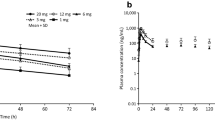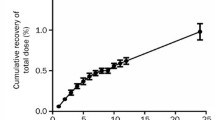Abstract
To study the plasma pharmacokinetics and accumulation of the recombinant human parathyroid hormone (rhPTH) (1–84) in rhesus monkeys, and the tissue distribution and excretion profiles of 125I-rhPTH (1–84) in rats. The concentration of rhPTH (1–84) in plasma samples were determined by an enzyme immunoassay (EIA) method after subcutaneous and intravenous bolus injection. The tissue distribution and urinary, fecal and biliary excretion patterns of 125I-rhPTH (1–84) were investigated by trichloroacetic acid (TCA) precipitation method. Following subcutaneous (sc) administration rhPTH (1–84) in rhesus monkeys, rhPTH (1–84) exhibited rapid absorption and elimination and had no accumulated tendency after successive sc administration. Following sc administration 125I-rhPTH (1–84) in rats, the TCA-precipitated radioactivity was widely distributed and rapidly diminished in most tissues. Approximately 83.9 and 6.8 % of the total radioactivity was recovered in urine and feces by 72 h postdosing, respectively; whereas 4.1 % excreted into bile up to 24 h postdosing. The pharmacokinetics of rhPTH (1–84) complied with linear kinetics within the examined dose range following a single sc administration had no accumulated tendency following multiple sc administration in rhesus monkeys. The accumulation of 125I-rhPTH (1–84) in tissues/organs examined, appeared to be low in rats. The major elimination route was by urinary excretion.





Similar content being viewed by others
References
Neer, R. M., Arnaud, C. D., Zanchetta, J. R., Prince, R., Gaich, G. A., Reginster, J. Y., et al. (2001). Effect of parathyroid hormone (1–34) on fractures and bone mineral density in postmenopausal women with osteoporosis. New England Journal of Medicine, 344, 1434–1441.
Paschalis, E. P., Glass, E. V., Donley, D. W., & Eriksen, E. F. (2005). Bone mineral and collagen quality in iliac crest biopsies of patients given Teriparatide: New results from the fracture prevention trial. Journal of Clinical Endocrinology and Metabolism, 90, 4644–4649.
Gardella, T. J., & Juppner, H. (2000). Interaction of PTH and PTHrP with their receptors. Reviews in Endocrine and Metabolic Disorders, 1, 317–329.
Habener, J. F., Rosenblatt, M., & Potts, J. T, Jr. (1984). Parathyroid hormone: Biochemical aspects of biosynthesis, secretion, action, and metabolism. Physiological Reviews, 64, 985–1053.
Mannstadt, M., Juppner, H., & Gardella, T. J. (1999). Receptors for PTH and PTHrP: Their biological importance and functional properties. American Journal of Physiology, 277, F665–F675.
Quattrocchi, E., & Kourlas, H. (2004). Teriparatide: A review. Clinical Therapeutics, 26, 841–854.
Close, P., Neuprez, A., & Reginster, J. Y. (2006). Developments in the pharmacotherapeutic management of osteoporosis. Expert Opinion on Pharmacotherapy, 7, 1603–1615.
Cosman, F., & Lindsay, R. (2004). Therapeutic potential of parathyroid hormone. Current Osteoporosis Reports, 2, 5–11.
Ettinger, M., Greenspan, S., Marriott, T., Hanley, D., Zanchetta, J., & Bone, H. (2004). PTH (1–84) prevents first vertebral fracture in postmenopausal women with osteoporosis: the TOP study (abstract). Salt Lake City: NPS Pharmaceuticals.
Black, D. M., Greenspan, S. L., Ensrud, K. E., Palermo, L., McGowan, J. A., Lang, T. F., et al. (2003). The effects of parathyroid hormone and alendronate alone or in combination in postmenopausal osteoporosis. New England Journal of Medicine, 349, 1207–1215.
Black, D. M., Greenspan, S. L., Ensrud, K. E., Palermo, L., McGowan, J. A., & Lang, T. F. (2004). The effects of PTH, alendronate alone or in combination on bone mass and turnover: 24 month results of the PaTH trial (abstract). Salt Lake City: NPS Pharmaceuticals.
Shrader, S. P., & Ragucci, K. R. (2005). Parathyroid hormone (1–84) and treatment of osteoporosis. New Drug Development, 39, 1511–1516.
Rao, L. G., & Murray, T. M. (1985). Binding of intact parathyroid hormone to rat osteosarcoma cells: major contribution of binding sites for carboxyl-terminal region of the hormone. Endocrinology, 117, 1632–1638.
Divieti, P., Inomata, N., Chapin, K., Singh, R., Jüppner, H., & Bringhurst, F. R. (2001). Receptors for the carboxyl-terminal region of PTH (1–84) are highly expressed in osteocytic cells. Endocrinology, 142, 916–925.
Jilka, R. L., Weinstein, R. S., Bellido, T., Roberson, P., Parfitt, A. M., & Manolagas, S. C. (1999). Increased bone formation by prevention of osteoblast apoptosis with parathyroid hormone. The Journal of Clinical Investigation, 104, 439–446.
Manolagas, S. C. (2000). Birth and death of bone cells: Basic regulatory mechanisms and implications for the pathogenesis and treatment of osteoporosis. Endocrine Reviews, 21, 115–137.
Nickols, G. A., Metz-Nickols, M. A., Pang, P. K., Roberts, M. S., & Cooper, C. W. (1989). Identification and characterization of parathyroid hormone receptors in rat renal cortical plasma membranes using radioligand binding. Journal of Bone and Mineral Research, 4, 615–623.
Dunne, A. (1993). Statistical moments in pharmacokinetics: Models and assumptions. Journal of Pharmacy and Pharmacology, 45, 871–875.
Groen, E. W. J., Schwietert, H. R., & Van Marle, S. P. (1995). Multiple dose administration of recombinant human parathyroid hormone in healthy postmenopausal volunteers (abstract). Therapie, 50, 525.
Neuman, W. F., Neuman, M. W., Lane, K., Miller, L., & Sammon, P. J. (1975). The metabolism of labeled parathyroid hormone. V collected biological studies. Calcified Tissue Research, 18, 271–287.
Hu, Z. P., Niu, H. S., Yang, X. X., Li, H. F., Sang, G. W., & Li, B. (2006). Recombinant human parathyroid hormone 1–34: Pharmacokinetics, tissues distribution and excretion in rats. International Journal of Pharmaceutics, 317, 144–154.
Gensure, R. C., Gardella, T. J., & Juppner, H. (2005). Parathyroid hormone and parathyroid hormone-related peptide, and their receptors. Biochemical and Biophysical Research Communications, 328, 666–678.
Gardella, T. J., & Juppner, H. (2001). Molecular properties of the PTH/PTHrP receptor. Trends in Endocrinology and Metabolism, 12, 210–217.
Urena, P., Kong, X. F., Abou-Samra, A. B., Juppner, H., Kronenberg, H. M., Potts, J. T, Jr., et al. (1999). Parathyroid hormone (PTH)/PTH-related peptide receptor messenger ribonucleic acids are widely distributed in rat tissues. Endocrinology, 133, 617–623.
Rampe, D., Lacerda, A. E., Dage, R. C., & Brown, A. M. (1991). Parathyroid hormone: An endogenous modulator of cardiac calcium channels. American Journal of Physiology, 261, H1945–H1950.
Juppner, H., Schipani, E., Bringhurst, F. R., McClure, I., Keutman, H. T., Potts, J. T, Jr, et al. (1994). The extracellular amino-terminal region of the parathyroid hormone (PTH)/PTH-related peptide receptor determines the binding affinity for carboxyl-terminal of PTH (1–34). Endocrinology, 134, 879–884.
Daugaard, H., Egfjord, M., Lewin, E., & Olgaard, K. (1994). Metabolism of N-terminal and C-terminal parathyroid hormone fragments by isolated perfused rat kidney and liver. Endocrinology, 134, 1373–1381.
Hruska, K. A., Korkor, A., Martin, K., & Slatopolsky, E. (1981). Peripheral metabolism of intact parathyroid hormone. Journal of Clinical Investigation, 67, 885–892.
Author information
Authors and Affiliations
Corresponding author
Rights and permissions
About this article
Cite this article
Bai, H., Jing, D., Jiang, H. et al. Pharmacokinetics, Tissue Distribution and Excretion of Recombinant Human Parathyroid Hormone 1–84 in Animals. Cell Biochem Biophys 66, 379–387 (2013). https://doi.org/10.1007/s12013-012-9477-4
Published:
Issue Date:
DOI: https://doi.org/10.1007/s12013-012-9477-4




